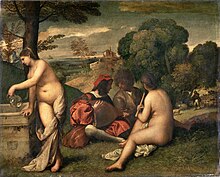Conversation piece (art)


Konversationsstück (more rarely: conversation picture ) is the name for a genre in painting and graphics that shows sociability or people in conversation. As a genre of its own, conversation pieces had their heyday in European art in the 17th and 18th centuries.
Subject matter
Conversation pieces combine socializing and conversations with various other motifs and genres, for example with musical performances, banquets or declarations of love; board games and alcohol consumption can also be the subject of the pictures. The milieus includes private domesticity ( interiors ), but also outdoor societies or places for public socializing, such as depictions of people in the theater or in the coffee house. Dutch painting also dealt with the world of the peasant lower class, often with a mocking undertone, whereas the clients like to show themselves as educated cosmopolitan citizens in harmonious domesticity.
history
As courtly conversation gallant ( gallant Entertainment ) the subject in Europe first appeared on French tapestries of the 14th century and then especially in the Venetian Renaissance painting to be found, for example in Giorgione's Concert (ca. 1510).
In the 17th century, the conversation piece became a genre of its own as painting specialized in depicting reality for upscale bourgeois living spaces, for example by Jan Vermeer , Pieter de Hooch , Gabriel Metsu and Gerard Terborch .
The Venetian works of the 18th century show the social life in the Ridotti (singular: Ridotto ), the private smaller reception rooms of the wealthy upper class that are only accessible to a select group and were mostly painted for these rooms. In Venice they were often self-deprecating and thus enabled their owner to take a superior position when talking to his guests and above petty criticism. As with the carnival , the playful breaking of taboos and ambiguous abysmalness were cultivated, especially by the painter Pietro Longhi, who was particularly popular with noble buyers .
In the 18th century it also caught on in French and English painting, for example in the fêtes galantes Antoine Watteau and Jean-Honoré Fragonards or the "conversation pieces" by William Hogarth , Gawen Hamilton and Arthur Devis. In the 19th and 20th centuries it experienced, especially with the motif of the table discussion, many variations, for example, in Menzel's round table of Frederick II. In Sanssouci (1850) to the family of the painter by Henri Matisse (1911).
literature
- Mario Praz: Conversation Pieces. A Survey of the Informal Group Portrait in Europe and America . Pennsylvania State University Press, University Park and London 1971.
- Lexicon of Art Volume II. Berlin, 1981; P. 687
- Uwe M. Schneede : The representative image of society in Dutch painting of the 17th century and its foundations in H. Vredeman de Vries . Kiel 1965
Web links
- The large art lexicon by PW Hartmann: Konversationsstück at: BeyArs.com (accessed on September 2, 2012)
- National Gallery of Art , Washington DC: Tour: British Conversation Pieces and Portraits of the 1700s
Individual evidence
- ↑ a b Sabine Poeschel: Handbook of Iconography - Sacred and profane themes of the visual arts . 5th edition. Verlag Philipp von Zabern / WBG, Darmstadt 2014, ISBN 978-3-8053-4831-7 , p. 390 ff .
- ↑ a b Lexikon der Kunst (1981), p. 687
